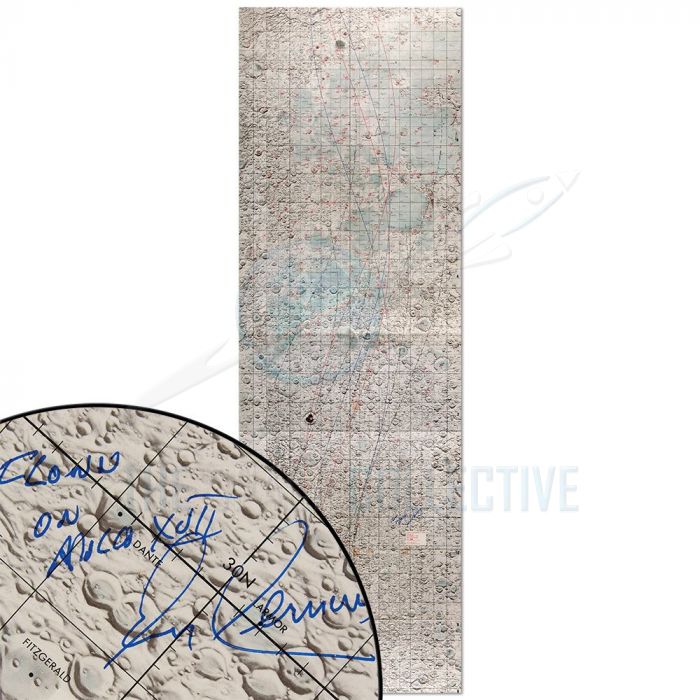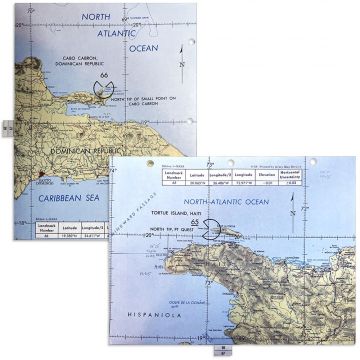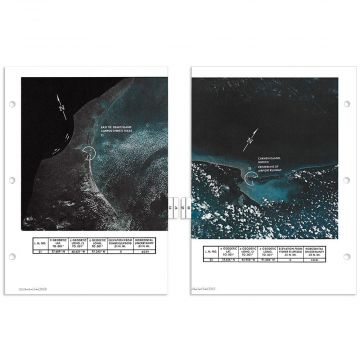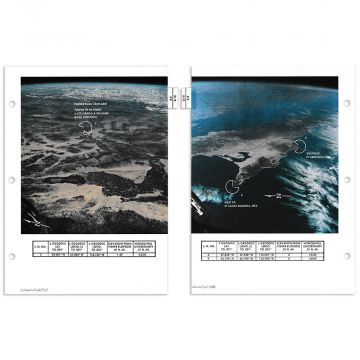

Apollo 17 Lunar Orbit Flown Contingency Map Plates
Lunar orbit flown lunar contingency map plates carried to the moon aboard the Command Module "America" during the Apollo 17 mission. Originally from the collection of Apollo 17 Commander Gene Cernan. Each map plate measures approximately 12.5" x 8".
Out of stock
DESCRIPTION
Apollo 17 contingency map plates flown to the moon aboard the Command Module "America" during the last mission, Apollo 17, in December 1972.
The chart is identified by the legend box as "Lunar Contingency Chart, Apollo 17, December 6, 1972, SKB 32100123-382, S/N 1001, 1st Edition September 29, 1972, Mercator Projection, Scale 1:5,500,000 at the Equator." The highly detailed moon maps identify hundreds of lunar landmarks, with orbital paths and photography information indicated. Full line plots of lunar orbit ground tracks are shown with multiple colors depending on which particular orbit is plotted; lunar topography is shown by shaded relief with a western illumination and includes revolution numbers and times of crossing. Background coloration also indicates variance in the reflectance of lunar areas under full illumination.
Product Information:
- Select your desired map plate
- Each map measures approx. 12.5" x 8"
- Includes a copy of the original CDR Gene Cernan letter of authenticity
- Includes a copy of the Apollo 17 stowage list with the map highlighted
- Includes certificate of authenticity with holographic logo and company stamp
Available Map Plates:
- Map Plate A1 - Darwin crater, a walled plain lunar impact crater, is located in the center-right of the map. The crater is named after the naturalist, geologist, and biologist, Charles Darwin, famously known for his Theory of Evolution. This plate measures approx. 12.5" x 7".
- Map Plate A2 - Einstein and Bohr craters are located in the top-left of the map. The craters are named after the famous theoretical physicists and Nobel Prize winners, Albert Einstein and Neils Bohr. Einstein was famously known for developing the Theory of Relativity, and Bohr for his foundational contributions to understanding atomic structure and Quantum Theory. Galilaei crater is also present in the bottom-left of the map and is named after Galileo Galilei (1564–1642), the Italian astronomer, physicist, and engineer. This plate measures approx. 12.5" x 7".
- Map Plate B1 - Euclides crater is a small lunar impact crater located near the eastern edge of Oceanus Procellarum and is named after the Ancient Greek mathematician Euclid who lived sometime around 300 BC. Euclid is known for the Elements treatise, which established the foundations of geometry that largely dominated the field until the early 19th century.
- Map Plate B2 - Kepler crater, a lunar impact crater that lies between the Oceanus Procellarum to the west and Mare Insularum to the east, is located in the middle-left section of the map. The crater is named after the 17th-century German astronomer and mathematician Johannes Kepler, famously known for his laws of planetary motion.
- Map Plate C1 - The Apollo 14 Fra Mauro landing site is located in the top-right corner. Tycho, a prominent lunar impact crater in the southern lunar highlands, is in the top-left. The crater is named after the Danish astronomer Tycho Brahe (1546–1601) and is estimated to be 108 million years old.
- Map Plate C2 - The Apollo 15 Hadley Rille landing site is located near the center of the map. Hadley Rille is named after British scientist and mathematician John Hadley (1682-1744).
- Map Plate D1 - The Apollo 16 Descartes Highlands landing site is located in the top-right of the map. The text for Descartes, however, is located on map C-1.
- Map Plate D2 - This map plate features the first and last Apollo lunar landing sites. The Apollo 11 Sea of Tranquility landing site is located in the top-left corner of the map, and the Apollo 17 Taurus-Littrow Valley landing site is located near the middle of the map.
- Map Plate E1 - The Luna 16 landing site is located in the top-right corner of the map. Luna 16 was part of the Soviet Luna Program and was the first robotic probe to land on the Moon and return a sample of lunar soil to Earth.
- Map Plate E2 - The Luna 18, 20, 23 & 24 landing sites are located in the top-left corner of the map. All probes were part of the Soviet Luna Program. The Luna missions were designed to collect information about the environment on the lunar surface and assist in planning future manned lunar missions. Hubble crater is also located at the bottom of the map, named for the famous American astronomer, Edwin Hubble.
- Map Plate F1 -Sklodowska crater is located near the top-right of the map. Sklodowska is a large lunar impact crater on the far side of the Moon and can sometimes be viewed from Earth under favorable conditions. The crater is named after Marie Curie, specifically Maria Skłodowska-Curie, the famous Polish physicist and chemist who conducted pioneering research on radioactivity.
- Map Plate F2 - Fleming crater is located on the middle-left side of the map. Fleming was named after Scottish-born astronomer Williamina Fleming (1857 – 1911), and biologist, physician, microbiologist, and pharmacological Alexander Fleming.
- Map Plate G1 - Gagarin crater is located in the bottom-right corner of the map. The crater was named after cosmonaut Yuri Gagarin, the first human in space. The six craters falling within the perimeter of Gagarin have also been named after Russian aviation and astronautics pioneers, including Isaev, Grave, Balandin, Raspletin, Kosberg, and Andronov.
- Map Plate G2 - This map plate features two craters named after famous Cosmonauts. Tereshkova crater, named after cosmonaut Valentina Tereshkova, the first woman in space, is located near the middle of the map. Leonov crater, named after cosmonaut Alexi Leonov, the first person to conduct a spacewalk, is located further southwest.
- Map Plate H1 - Oppenheimer crater, a large lunar impact crater located on the far side of the moon, is located at the bottom of the map. The crater is named after Robert Oppenheimer, "father of the atomic bomb."
- Map Plate H2 - Zhugovsky crater, a lunar impact crater located on the far side of the moon, is located at the bottom-left of the map. The crater is named after Nikolay Zhukovsky, known as the "father of Russian aviation." Signed & inscribed with "Flown on Apollo XVII / Gene Cernan."
- Map Plate I1 - Apollo crater, also known as the Apollo Basin, an enormous impact crater located in the southern hemisphere on the far side of the moon, is located on the left side of the map. Surrounding the crater are multiple smaller craters named after the crews of Apollo 1 and 8; Borman, Lovell, Anders, Grissom, Chaffee, and White.
- Map Plate I2 - Mach crater is located in the middle-left of the map. The crater is located on the far side of the moon and was named after the Austrian physicist and philosopher Ernst Mach, who contributed to the physics of shock waves, and for whom the Mach number was named.
- Map Plate J1 - The Eastern Sea, otherwise known as Mare Orientale, is a lunar mare visible on the lower half of the map. The Eastern Sea is located on the western border of the near and far sides of the Moon, making it difficult to see from an Earthbound perspective.
- Map Plate J2 - Nobel crater is located in the bottom-left of the map. The crater is located on the far side of the moon and is named after Alfred Nobel, famously known for bequeathing his fortune to establish the Nobel Prize and less famously known for inventing dynamite in 1867.
Purchasing Multiple Map Plates:
If you would like to purchase multiple maps and do not want them separated into individual plates (i.e. A1 & A2 adjoining), please send an email to [email protected] after placing your order, and we will arrange for the map plates to be sent to you joined together. Please note that if your map plates are adjoining, our acrylic frames will not fit as they are designed for individual plates only.
Condition Report:
Tape marks from period tape is visible on the reverse side of the following maps and bleed through to the front, although this does not detract from the overall look and appeal of the plates: B2, D1, F2, I1, I2, J2. In fine condition.
Authentication Information:
This Apollo 17 flown map came from the collection of Mission Commander Gene Cernan. One section (H-2) of the chart is hand-signed and flight-certified in blue felt tip, "Flown on Apollo XVII / Gene Cernan." The chart is identified in the legend box and bears the serial numbers "32100123-382, S/N 1001," which correspond with those found in the Apollo 17 stowage list, which will also be included with each map plate.
Each map plate comes with a copy of the signed letter of authenticity from Cernan, reading in part: “I hereby certify that the Apollo 17 Command Module Flown Lunar Orbit Contingency Chart which accompanies this letter was flown with me to the moon aboard the Apollo 17 mission, December 7-19, 1972."
Lifetime Guarantee of Authenticity:
All of our artifacts are thoroughly and extensively researched before being listed for sale, so much so that we're proud to offer a lifetime guarantee of authenticity for this and other artifacts listed on our website. We also hold a record of every piece we sell, which can be identified and searched in our online database using the serial number listed on your certificate of authenticity.
Description
Apollo 17 contingency map plates flown to the moon aboard the Command Module "America" during the last mission, Apollo 17, in December 1972.
The chart is identified by the legend box as "Lunar Contingency Chart, Apollo 17, December 6, 1972, SKB 32100123-382, S/N 1001, 1st Edition September 29, 1972, Mercator Projection, Scale 1:5,500,000 at the Equator." The highly detailed moon maps identify hundreds of lunar landmarks, with orbital paths and photography information indicated. Full line plots of lunar orbit ground tracks are shown with multiple colors depending on which particular orbit is plotted; lunar topography is shown by shaded relief with a western illumination and includes revolution numbers and times of crossing. Background coloration also indicates variance in the reflectance of lunar areas under full illumination.
Product Information:
- Select your desired map plate
- Each map measures approx. 12.5" x 8"
- Includes a copy of the original CDR Gene Cernan letter of authenticity
- Includes a copy of the Apollo 17 stowage list with the map highlighted
- Includes certificate of authenticity with holographic logo and company stamp
Available Map Plates:
- Map Plate A1 - Darwin crater, a walled plain lunar impact crater, is located in the center-right of the map. The crater is named after the naturalist, geologist, and biologist, Charles Darwin, famously known for his Theory of Evolution. This plate measures approx. 12.5" x 7".
- Map Plate A2 - Einstein and Bohr craters are located in the top-left of the map. The craters are named after the famous theoretical physicists and Nobel Prize winners, Albert Einstein and Neils Bohr. Einstein was famously known for developing the Theory of Relativity, and Bohr for his foundational contributions to understanding atomic structure and Quantum Theory. Galilaei crater is also present in the bottom-left of the map and is named after Galileo Galilei (1564–1642), the Italian astronomer, physicist, and engineer. This plate measures approx. 12.5" x 7".
- Map Plate B1 - Euclides crater is a small lunar impact crater located near the eastern edge of Oceanus Procellarum and is named after the Ancient Greek mathematician Euclid who lived sometime around 300 BC. Euclid is known for the Elements treatise, which established the foundations of geometry that largely dominated the field until the early 19th century.
- Map Plate B2 - Kepler crater, a lunar impact crater that lies between the Oceanus Procellarum to the west and Mare Insularum to the east, is located in the middle-left section of the map. The crater is named after the 17th-century German astronomer and mathematician Johannes Kepler, famously known for his laws of planetary motion.
- Map Plate C1 - The Apollo 14 Fra Mauro landing site is located in the top-right corner. Tycho, a prominent lunar impact crater in the southern lunar highlands, is in the top-left. The crater is named after the Danish astronomer Tycho Brahe (1546–1601) and is estimated to be 108 million years old.
- Map Plate C2 - The Apollo 15 Hadley Rille landing site is located near the center of the map. Hadley Rille is named after British scientist and mathematician John Hadley (1682-1744).
- Map Plate D1 - The Apollo 16 Descartes Highlands landing site is located in the top-right of the map. The text for Descartes, however, is located on map C-1.
- Map Plate D2 - This map plate features the first and last Apollo lunar landing sites. The Apollo 11 Sea of Tranquility landing site is located in the top-left corner of the map, and the Apollo 17 Taurus-Littrow Valley landing site is located near the middle of the map.
- Map Plate E1 - The Luna 16 landing site is located in the top-right corner of the map. Luna 16 was part of the Soviet Luna Program and was the first robotic probe to land on the Moon and return a sample of lunar soil to Earth.
- Map Plate E2 - The Luna 18, 20, 23 & 24 landing sites are located in the top-left corner of the map. All probes were part of the Soviet Luna Program. The Luna missions were designed to collect information about the environment on the lunar surface and assist in planning future manned lunar missions. Hubble crater is also located at the bottom of the map, named for the famous American astronomer, Edwin Hubble.
- Map Plate F1 -Sklodowska crater is located near the top-right of the map. Sklodowska is a large lunar impact crater on the far side of the Moon and can sometimes be viewed from Earth under favorable conditions. The crater is named after Marie Curie, specifically Maria Skłodowska-Curie, the famous Polish physicist and chemist who conducted pioneering research on radioactivity.
- Map Plate F2 - Fleming crater is located on the middle-left side of the map. Fleming was named after Scottish-born astronomer Williamina Fleming (1857 – 1911), and biologist, physician, microbiologist, and pharmacological Alexander Fleming.
- Map Plate G1 - Gagarin crater is located in the bottom-right corner of the map. The crater was named after cosmonaut Yuri Gagarin, the first human in space. The six craters falling within the perimeter of Gagarin have also been named after Russian aviation and astronautics pioneers, including Isaev, Grave, Balandin, Raspletin, Kosberg, and Andronov.
- Map Plate G2 - This map plate features two craters named after famous Cosmonauts. Tereshkova crater, named after cosmonaut Valentina Tereshkova, the first woman in space, is located near the middle of the map. Leonov crater, named after cosmonaut Alexi Leonov, the first person to conduct a spacewalk, is located further southwest.
- Map Plate H1 - Oppenheimer crater, a large lunar impact crater located on the far side of the moon, is located at the bottom of the map. The crater is named after Robert Oppenheimer, "father of the atomic bomb."
- Map Plate H2 - Zhugovsky crater, a lunar impact crater located on the far side of the moon, is located at the bottom-left of the map. The crater is named after Nikolay Zhukovsky, known as the "father of Russian aviation." Signed & inscribed with "Flown on Apollo XVII / Gene Cernan."
- Map Plate I1 - Apollo crater, also known as the Apollo Basin, an enormous impact crater located in the southern hemisphere on the far side of the moon, is located on the left side of the map. Surrounding the crater are multiple smaller craters named after the crews of Apollo 1 and 8; Borman, Lovell, Anders, Grissom, Chaffee, and White.
- Map Plate I2 - Mach crater is located in the middle-left of the map. The crater is located on the far side of the moon and was named after the Austrian physicist and philosopher Ernst Mach, who contributed to the physics of shock waves, and for whom the Mach number was named.
- Map Plate J1 - The Eastern Sea, otherwise known as Mare Orientale, is a lunar mare visible on the lower half of the map. The Eastern Sea is located on the western border of the near and far sides of the Moon, making it difficult to see from an Earthbound perspective.
- Map Plate J2 - Nobel crater is located in the bottom-left of the map. The crater is located on the far side of the moon and is named after Alfred Nobel, famously known for bequeathing his fortune to establish the Nobel Prize and less famously known for inventing dynamite in 1867.
Purchasing Multiple Map Plates:
If you would like to purchase multiple maps and do not want them separated into individual plates (i.e. A1 & A2 adjoining), please send an email to [email protected] after placing your order, and we will arrange for the map plates to be sent to you joined together. Please note that if your map plates are adjoining, our acrylic frames will not fit as they are designed for individual plates only.
Condition Report:
Tape marks from period tape is visible on the reverse side of the following maps and bleed through to the front, although this does not detract from the overall look and appeal of the plates: B2, D1, F2, I1, I2, J2. In fine condition.
Authentication Information:
This Apollo 17 flown map came from the collection of Mission Commander Gene Cernan. One section (H-2) of the chart is hand-signed and flight-certified in blue felt tip, "Flown on Apollo XVII / Gene Cernan." The chart is identified in the legend box and bears the serial numbers "32100123-382, S/N 1001," which correspond with those found in the Apollo 17 stowage list, which will also be included with each map plate.
Each map plate comes with a copy of the signed letter of authenticity from Cernan, reading in part: “I hereby certify that the Apollo 17 Command Module Flown Lunar Orbit Contingency Chart which accompanies this letter was flown with me to the moon aboard the Apollo 17 mission, December 7-19, 1972."
Lifetime Guarantee of Authenticity:
All of our artifacts are thoroughly and extensively researched before being listed for sale, so much so that we're proud to offer a lifetime guarantee of authenticity for this and other artifacts listed on our website. We also hold a record of every piece we sell, which can be identified and searched in our online database using the serial number listed on your certificate of authenticity.



